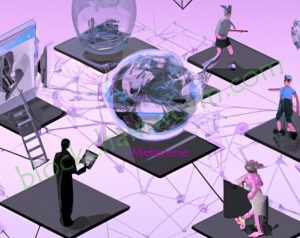Page Contents :
The Foundation Of Metaverse Economic
In recent years, investment in Metaverse-related projects has been on the rise.
Many experts predict that it will replace the Internet and form a new economic system.
Metaverse is built upon six core technologies: Blockchain, Interactivity ![]() , Game, Artificial Intelligence (AI), Network, and Internet of Things (IoT).
, Game, Artificial Intelligence (AI), Network, and Internet of Things (IoT).
These technologies are represented by the acronym “BIGANT“.
Among these technologies, Blockchain ![]() plays a crucial role in the development of the metaverse.
plays a crucial role in the development of the metaverse.
The metaverse is a virtual space where users and players can create their own Avatars and participate in real-time interactions.
The fusion of the digital and physical worlds of the metaverse offers exciting opportunities.
With this comes the potential for the creation of a new Digital Economic System (aka Metaverse Economy or Meta-Economy).
However, for this new economy to flourish, there needs to be a reliable and secure system of transactions and asset ownership.
This is where blockchain technology comes in and ensures the integrity of the meta-economy.
Experts predict that the economic value of the Metaverse will reach 800 billion US dollars by 2024.
With its ability to provide a decentralized and transparent way to conduct transactions and verify ownership of virtual assets in the metaverse.
Blockchain technology is poised to be a key driver in the growth and development of the meta-economy.
4 Key Technologies Of Blockchain
The implementation of blockchain technology in the meta-economy is set to revolutionize the way we interact and transact in the digital world.
By leveraging the power of blockchain key technologies, the metaverse is creating a safer, more efficient, and more transparent digital economy.
∮ Digital Identity
One of the most critical aspects of the metaverse is Digital Identity.
In the real world, our identities are tied to our legal names and birth certificates.
Powered by blockchain technology, metaverse allows users a way to create and manage digital identities.
In the digital world, authenticating users’ identities and ensuring they are who they claim to be, and preventing fraud is critical.
Blockchain technology provides a secure and transparent way to verify identities, creating a more secure and trustworthy environment for user interactions and transactions.
∮ Non-Fungible Token
Non-Fungible Tokens (NFTs) are a set of unique and indivisible data points on the blockchain.
It is a unique and non-replicable item stored on the blockchain.
The immutability and transparency of these unique data points make them the perfect digital asset for the meta-economy.
NFT can be any commodity with digital value, such as virtual assets, digital collectibles, service commodities, in-game commodities, and more.
These digital assets have real-world value.
NFTs create unique opportunities for users to share, collaborate and invest in the value of digital goods and services.
∮ Decentralization
Decentralization ![]() is another key technology of blockchain that enables multiple users to participate in decision-making without being owned or controlled by a single entity or organization.
is another key technology of blockchain that enables multiple users to participate in decision-making without being owned or controlled by a single entity or organization.
The meta-economy subverts the traditional economic system manipulated by the central government or corporate institutions and develops towards a decentralized system.
This creates a more democratic and level playing field for every participant, regardless of background or status.
With the help of blockchain technology, the metaverse becomes a more secure, private, and reliable place to store and manage digital assets.
Users can easily buy and sell virtual assets, verifying that transactions are more transparent and secure, reducing the risk of fraud and errors.
∮ Immutability Of Distributed Ledgers And Transactions
The Immutability of Distributed Ledgers and Transactions ![]() is the most critical feature of blockchain technology.
is the most critical feature of blockchain technology.
This ensures the integrity of transaction data, and that all transactions are transparent and secure.
It removes the need for third-party intermediaries to verify transactions, making the transaction process faster and more efficient.
The absence of intermediaries also reduces the risk of fraud, as there is no central point of control that can be compromised.
This ensures that users can manage their digital assets securely and cannot be modified or deleted.
Blockchain technology is used to secure digital assets and facilitate transactions between two or more parties.
The immutability of blockchain technology reduces the risk of fraud or double spending, providing users with a reliable platform to conduct transactions and store digital assets.
This reduces the risk of fraud as no intermediaries are involved while protecting the privacy of users.
Blockchain technology creates a more secure and trustworthy meta-economy, which benefits users, developers, and investors.
At the same time, it has created new jobs where users can earn a living by creating and selling virtual goods and services.
Key Challenges To Be Addressed
The development of the meta-economy will give rise to various challenges and issues such as personal information, virtual property, data security, and new types of crimes.
Therefore, it is important to think ahead about how to prevent and address these challenges and constraints in order to achieve successful development in the meta-economic sphere.
∮ Scalability
The sheer volume of transactions and data generated by the meta-economy may exceed the capabilities of traditional blockchain systems.
This can lead to slow transaction speeds, high fees, and limitations on the number of users who can participate in the economy.
Therefore, it is crucial to develop efficient and scalable blockchain solutions to support the growing demand for transaction data.

Scalability to support meta-economic growth
To address this challenge, developers are exploring new approaches to blockchain technology, such as blockchain layer-2 solutions: Sharding and Sidechains.
The layer-2 network can solve the scalability problem existing in the layer-1 network of the blockchain.
Sharding increases transaction output by dividing the network into different shards.
That is, splitting a set of data into smaller, more manageable pieces.
After a node completes a shard, it broadcasts it to the blockchain, where it is then verified.
Sidechains are separate blockchains that are still connected to the main blockchain but use their own consensus mechanism to confirm transactions.
This can provide increased privacy and scalability, as they can handle a large number of transactions without slowing down the mainchain.
∮ Virtual Asset Regulation
The meta-economy is decentralized, and its virtual assets can be traded globally.
This means that regulators cannot monitor and enforce regulations on metaverse transactions.
Virtual assets are digital assets that are owned and traded in the metaverse.
They can be anything, including virtual land, in-game items, digital currency, or even intellectual property.
As the meta-economy develops, more and more transactions take place in the metaverse.
Regulators and industry developers need to work together to develop rules and guidelines for data security, privacy protection, and intellectual property, among other digital virtual assets.
Blockchain technology must be able to comply with these regulations to ensure the rights and interests of all stakeholders in the meta-economy.
∮ Manipulation And Fraud Of Virtual Assets
The value of virtual assets in the meta-economy is real, and there is a risk of fraudsters trying to exploit that value.
Unlike traditional financial markets, the anonymous nature of the meta-economy makes abuse possible.
Industry developers must establish security and protection measures to prevent potential fraud and manipulation risks of virtual assets.
Market manipulation and spreading false information can lead to illegal profits, and therefore, appropriate measures must be taken to prevent such activities.
Cases Of Application
The metaverse on the blockchain platform is not just a concept, but a realization of a virtual world.
The metaverse is changing the way we interact with each other and the world around us, providing a platform for creativity and innovation.
Several games currently use blockchain technology, allowing users to own and control their assets while creating their own virtual worlds.
Let’s take a look at some of these cases of blockchain technology in action.
∮ Case 1: Decentraland
Decentraland is a virtual world composed of virtual land where users can create, experience, and monetize content and applications.
Decentraland uses the MANA token, a blockchain-based virtual currency, to allow users to buy and sell virtual land, goods, and services.
The MANA token is also used to incentivize content creation and reward users for their contributions to the Decentraland ecosystem.
∮ Case 2: Axie Infinity
Axie Infinity is a blockchain-based game economy platform that allows users to breed, fight and trade “Axies“, a type of digital pet.

Axie Infinity has created a unique Play to Earn (P2E) game ![]() where users can earn SLP tokens by playing games and participating in battles.
where users can earn SLP tokens by playing games and participating in battles.
SLP tokens can then be used to buy new Axies or sold on cryptocurrency exchanges for real-world currency.
∮ Case 3: Sandbox
The Sandbox is a decentralized gaming platform that allows users to create, share and monetize their own gaming experiences.
The Sandbox uses a blockchain-based virtual land ownership system where users can purchase and own virtual land using SAND tokens.
Users can then develop and monetize their virtual lands, selling in-game items and experiences to other users.
By creating blockchain-based virtual currencies, virtual land ownership systems, and in-game money-making economies, game developers are creating new opportunities for users to participate in and benefit from the meta-economy.
As the metaverse continues to evolve, we can expect to see even more innovations within the meta-economy.
The Future Development Direction
As the metaverse continues to expand, the potential uses of blockchain technology in the meta-economy are numerous.
Here are some future directions that blockchain technology could take:
∮ Interoperability And Cross-platform Transactions
Blockchain technology has the potential to facilitate interoperability between different virtual spaces and platforms.
By creating blockchain-based protocols and standards, users could transfer virtual assets between different metaverse ecosystems seamlessly.
Thereby creating a more connected and dynamic meta-economy.
∮ Decentralized Autonomous Organization
Blockchain technology can create a Decentralized Autonomous Organization (DAO) in the metaverse.

DAOs can enable virtual communities to pool resources and make collective decisions, enabling users to collectively govern and manage their virtual economy.
This could lead to more democratic decision-making processes and transparent distribution of resources in the virtual economy.
∮ GameFi
The integration of blockchain technology and Decentralized Finance into the Gaming Industry has led to the emergence of GameFi as a new trend in the meta-economy.
With GameFi, game developers are creating innovative opportunities for players to earn cryptocurrency while enjoying their favorite games.
This convergence of gaming and blockchain technology has opened up a whole new world of possibilities in the virtual economy and is changing the way we think about the intersection of finance and gaming.
Developers in the industry must continue exploring and realizing the application of blockchain technology in the metaverse, including the development of new protocols and standards.
As the metaverse continues to develop, blockchain technology has the potential to revolutionize the way we think about meta-economies.




